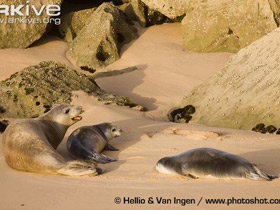The Mediterranean monk seal (Monachus monachus)
Mediterranean Monk Seal видео
The Mediterranean monk seal (Monachus monachus) is a monk seal belonging to the family Phocidae. As of 2015, it is estimated that fewer than 700 individuals survive in three or four isolated subpopulations in the Mediterranean, (especially) in the Aegean Sea, the archipelago of Madeira and the Cabo Blanco area in the northeastern Atlantic Ocean. It is believed to be the world's rarest pinniped species. This is the only species in the genus Monachus.
Habitat area
The Mediterranean monk seal (Monachus monachus) is a species of pinniped mammal of the phocidae family, one of the rarest in existence. It is critically endangered.
This extremely rare species is included in the IUCN Red List. Its numbers are estimated at only 600-700 individuals. It is found in the Black Sea, the Mediterranean Sea and the waters of the Atlantic Ocean adjacent to the Strait of Gibraltar. Sometimes found off the Black Sea coast near the Romanian border (Snake Island, Danube Delta). In the last century, this seal was quite widespread along the northwest Black Sea coast and even inhabited part of the Crimean coastal waters. Today, it probably inhabits the Black Sea coast of Romania, Bulgaria and Turkey.
In recent years it does not seem to have been seen in the Black Sea. Its range has also declined considerably in other waters. Until recently, it inhabited most of the coastal waters of the Mediterranean, but is now found only in a few places along the coast of Yugoslavia, Greece, Tunisia and Morocco, the islands of Sardinia and Corsica, the coast of Syria and Israel, and a few other places.
In the Atlantic Ocean, these seals are preserved in a few places off the coast of northwest Africa and off the island of Madeira. The largest colony of white-bellied seals is believed to be found there, with some 200 animals.
Appearance
Monachus monachus is characterised by a skull with widely spaced zygomatic arches (especially in older individuals) and a slightly flared nasal region. Unlike other seals, Monachus monachus has a highly developed posterior jaw. The cheek teeth are very close together and, as a rule, have no (if any, very small) additional vertexes. All cheek teeth, except the first pre-curved tooth, have two roots. The internal upper incisors have flattened roots.
The hind flippers have a fairly deep median notch and broad marginal lobes, the claws on them are very small. On the front fins the first toe is the longest, the rest gradually tapering towards the fifth; the claws are well developed, broad. The hair is low, stiff and smooth, strongly adhering to the body.
The colouring of adult seals is almost monochromatic, from dark grey to almost black, with a noticeable brown tinge in males; it becomes lighter towards the back and belly. The overall colouring of females is slightly lighter than that of males.
Males have a large, almost white, angular spot on the back (belly or belly) which females do not have.
This species ranges in length from 210 to 250 cm and weighs up to 300 kg.
Habitat and nutrition
The biology of Monachus monachus is poorly known. These diurnal animals seem to prefer small uninhabited islands or mostly rocky and inaccessible areas with chasms and caves on larger islands. Monachus monachus feeds on fish and large crustaceans. In the Black Sea they feed mainly on plaice, and to a lesser extent on mackerel and anchovies.
Reproduction
Females breed on islets and beaches protected from waves by reefs and located above high tide level. At selected sites, Monachus monachus breed annually.
They do not form large aggregations and congregate on beaches in small groups during the breeding season.
Monachus monachus seem to start breeding at 3-4 years of age. They mate in autumn or late summer, and gestation lasts 10-11 months. Females bear young in extended periods, from July to September, once every 1-2 years.
The body length of the newborn pups is about 100 cm and the weight is 15-16 kg. Their fur is rather long and soft, dark in colour, sometimes almost black on the back, a little lighter on the sides and even lighter on the abdomen. After the first moult, the pups acquire a short, stiff, two-coloured coat: dark grey on the back and almost white on the belly.
During the milk-feeding period, which lasts 6-8 weeks, the young remain on the shore and in the second month of life they learn to forage for their own food.
Conservation
Under the auspices of the Convention on Migratory Species of Wild Animals (CMS), also known as the Bonn Convention, the Memorandum of Understanding (MoU) concerning Conservation Measures for the Eastern Atlantic Populations of the Mediterranean Monk Seal was concluded and came into effect on 18 October 2007. The MoU covers four range States (Mauritania, Morocco, Portugal and Spain), all of which have signed, and aims at providing a legal and institutional framework for the implementation of the Action Plan for the Recovery of the Mediterranean Monk Seal in the Eastern Atlantic.
As there are indications of small population increases in the subpopulations, as of 2015, the Mediterranean monk seal's IUCN conservation status has been updated from critically endangered to endangered in keeping with the IUCN's speed-of-decline criteria.

















































